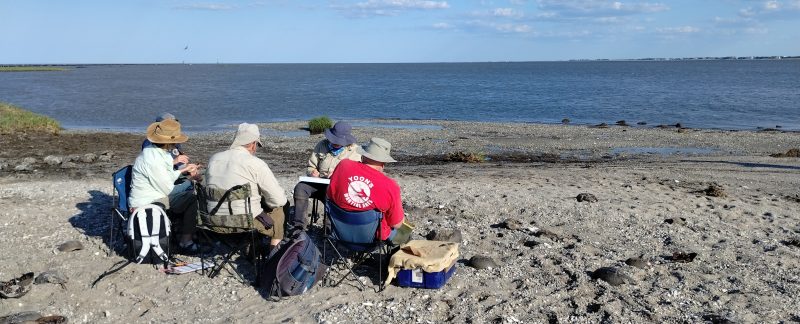Sunday 26 May
On the first day of week three in Delaware, Rob Rob, Chantal, Katharine and Kirsty left for Philadelphia to begin their journey home to the UK. They made the most of their last morning however, squeezing in one more resighting visit to Mispillion Harbor!
On their way to Osprey via Cedar Beach with Flo, a new volunteer got stuck in the deep mud. Showing their quick thinking and fantastic team strength, the Brits rallied together to undertake a quick and effective two-pronged rescue with help coming by boat and car/foot. Well done all!
Not many flags were spotted in Mispillion, it would seem many shorebirds were already migrating northwards. There is also the thought that more are heading to feed in New Jersey, where there are areas for roosting closer to the feeding sites. The evening harbour survey was cancelled due to an approaching storm, but this did not stop Ryan and Guy from cooking up an epic meal on the BBQ.
Those of us who remained in Delaware felt deflated in the evening, missing our friends who had departed. But the food did wonders to cheer us, and we managed to find our joy again, laughing into the night. During the evening meeting, plans were discussed for a catch on Swain’s Beach in the morning.
Monday 27 May
Despite our perseverance, we failed to catch on this day. This was possibly because we arrived at the beach to set too late and the Turnstone were already there, so setting our net simply caused them to head off to feed somewhere else – there is a lot of choice for the birds, with Horseshoe Crab eggs everywhere. An attempt to survey Mispillion was squashed too as the rains began to fall once more. On the plus side, the extra time at base gave us the opportunity to work on the build up of catch data that needed checking. Nigel and Jacquie made excellent progress through this.
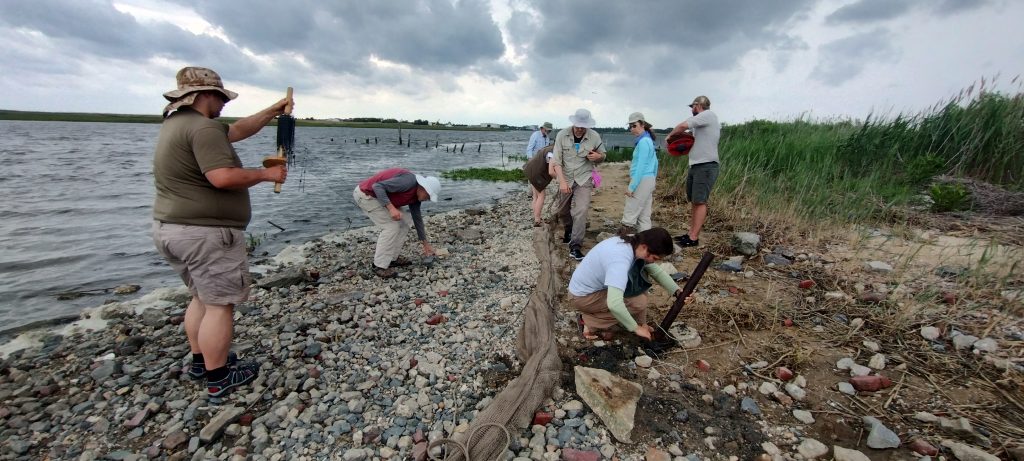
There was another visit to Cape Henlopen to check on Piping Plover breeding pairs and locate nests for exclosing in the near future. Large numbers of Sanderling were located on Point North when another boat was finally able to get out, so this was looking like a good potential for a future catch.
We adjusted timings based on tides and polished up our plan to reattempt a Turnstone catch on Swaine’s, aiming to arrive on the beach earlier than the birds the coming morning.
Tuesday 28 May
At 06:30, a small group went to set a net on Swaine’s. Back for a quick breakfast, then out again with the rest of the kit and team to form basecamp along Lighthouse Road. Guy, who had led the set, gave the catching briefing, and while Nigel was positioned on Osprey to watch the catching area, Ryan and Flo were on the firing box.
We waited a while for the tide to come up and birds to gather on the beach. The challenge of the day was that there were not many shorebirds in the harbour, and we suspected a Bald Eagle and Turkey Vulture perched on the rock walls were causing disturbance. Nigel decided we’d be waiting quite a while longer, so strolled off to do some resighting for a bit. Basecamp took the chance to fit in some well-needed naps!
In the end we made a small catch, and all birds were processed back at the house under the decking. The total number was 45: 29 Ruddy Turnstone, one Short-billed Dowitcher and 15 Semipalmated Sandpiper.
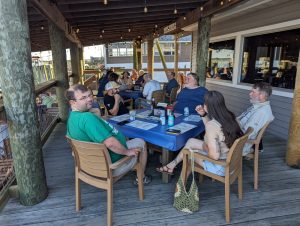
After lunch, we dispersed for the second aerial survey and this time round it was a first try success! On the drive back to the house, Guy and Flo stopped to observe a stunning flock of White Ibis trailing down Slaughter Beach. On getting out of the car, Flo’s phone had fallen out and Guy proceeded to run it over… It was quite unbelievable that the only evidence of this event was a dusty tyre mark over the screen!
In the evening, we scrubbed up and went out for a cheerful evening meal at JP’s with Kat, Jessie, Jim, Greg, Sally and, to everyone’s joy, Hen! Many things of great importance (and none at all!) were chatted over tasty food and we went home happy and relaxed.
Wednesday 29 May
Richard and Ryan left fairly early to catch a ferry to New Jersey to talk to Humphrey Sitters and Larry Niles about the project work on both sides of the bay. They also went to talk to researchers at CTT (Cellular Tracking Technologies) about new tagging projects. Those back at base cracked on with beach surveys and a good chunk of data checking was also completed.
An unexpected catching option was found just beyond the end of Cedar Beach when Flo stumbled upon 250+ Turnstone feeding on a small spit of sand and several hundred more (at least) roosting on the channel breakwall extending from Mispillion in the distance. This was very interesting as it was thought that most of the birds had already left for northern lands. The possibility to fit in one last catch was exciting! Guy came to recce the site and then that evening a plan was cooked up. Throughout the last few days, we have been pleased to see the occasional tagged Turnstone in the harbour. It is good to be able to collect some data from their movements within the bay in addition to their onward journey route.
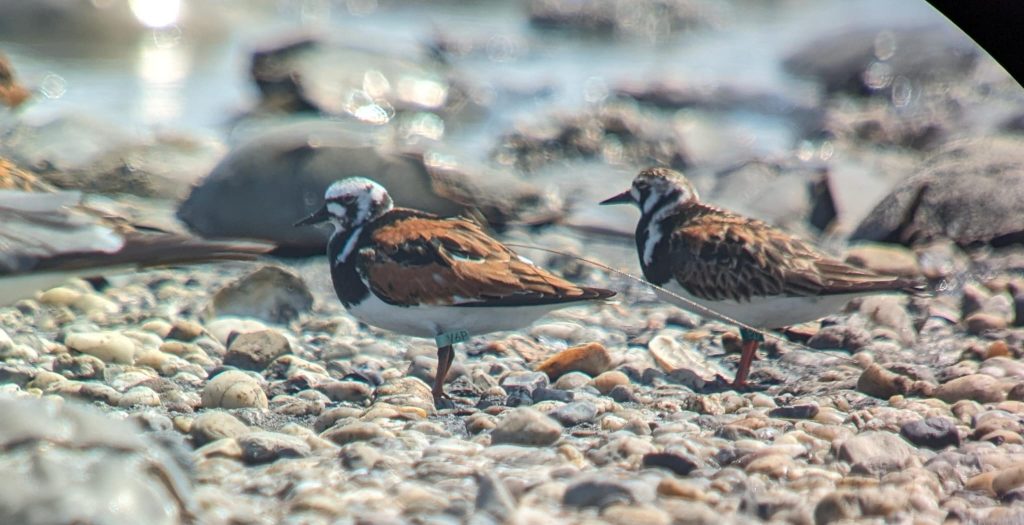
Just when everything seemed to be going so well, and everyone had gone to bed contented and looking forward to the day ahead, the ceiling of Nigel and Jacquie’s room decided to start leaking on to the bed! What a calamity. A large black box was installed on the bed to catch the water and they migrated into another room.
Thursday 30 May
Fortunately, in the morning Richard used a clever trick to figure out that the dripping water was in fact condensation from the air conditioning, so a temporary solution (turning off the air conditioning) was easy to put in place. To relieve himself from the stress of the whole event, Nigel ate flapjack for breakfast.
The setting kit was gathered and Nigel, Guy, Ema and Brian and Ryan (who were both already in the harbour having done an early Mispillion survey) boated round to just past Osprey. Here they anchored the Jon boat and transported the kit through the thick mud and vegetation until they reached the little beach and sand spit henceforth known as “Flo’s Point”. The net was set, a firing team positioned in a hide, and basecamp stationed in the grass, more team members soon arriving on the Skiff.
It was a lengthy wait for the tide to rise and roosting birds to take interest in the site. The shorebirds were easily put off and lifts occurred frequently. However, we continued to be patient as at least 2,000 Turnstone lined up on the breakwall made us hopeful that we’d be able to get a good sample.
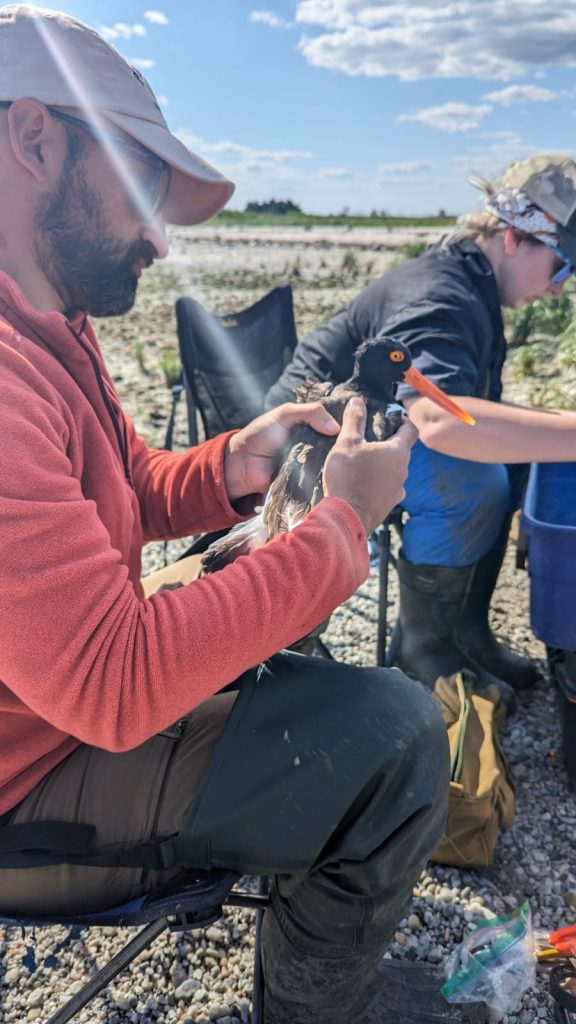
At long last, when the tide had risen fully, a good number of Turnstone descended on the point and settled… We caught 188 birds in total: 55 Ruddy Turnstone, two Sanderling, two Short-billed Dowitchers, 126 Semipalmated Sandpipers, two Dunlin and, a first for the project, an American Oystercatcher! It was a wet catch, but the team executed an expert tent lift to get the birds onto dry sand. Somehow, whilst running to the net from basecamp, Ryan lost his shoes, his third pair of the trip! We caught a green flagged Semipalmated Sandpiper which was probably flagged in 2023 on the New Jersey side.
After the catch, while most of the team returned home exhausted, Richard, Nigel, Guy, Ryan and Flo stayed to resight on Osprey. The warm sun set and a quiet peace enveloped them as they sat by the shore; so near to the end of the season, it made for quite an emotional hour or so – an evening to remember.
There was much positivity in the evening due to the success of catching a good sample of Turnstone on the ‘new’ beach, especially since late in the season mass data is rare but often informative! Heaps of shepherd’s pie made by Graham certainly factored into the team happiness.
Friday 31 May
A couple of hours of resighting in Mispillion in the morning was likely to be one of our last surveys of the season there. Again, there were very few shorebirds about, bar a handful of Turnstone on Osprey and Swain’s and a group of Sanderling on Back East.
The afternoon began with a team chat to sort out the finances from the last few weeks and draw out a big plan to get the house sorted and tidied before our departure the next day. And so, the great sad task of packing up began. We were kindly invited to Sam and Shawn’s for dinner and a chat, just like last year. Kat and Jessie joined us too and we were treated to a garden tour and lovely home-made quiche. Late into the evening we shared highlights and funny stories from our season in Delaware this year.
Saturday 1 June
Our last day in Delaware, we finished up cleaning through the house, gathered up our lost socks and went round to 456 to have a late pancake breakfast. We learned from Kat that one of our tagged Turnstone had already made it to its far north breeding grounds, such happy news!
Nigel and Guy took one last trip to Mispillion Harbour, and some last-minute data checking was completed at the house. Eventually, we had to face the sadness and say goodbye. We waved cheerio to Slaughter Beach and bid farewell to the wonderful American team we’d been working with. Thank you for such an incredible three weeks, filled with learning and laughter, it’s been a privilege to be a part of this project once again.
While Ema began the first leg of his journey that would eventually lead him back down to Argentina, the Brits made their way up to Philadelphia. After a quick visit to Bombay Hook and Cabela’s, we reached the airport. It was a bumpy flight and although weary and already missing the Bay, we eventually all made it safely home. Until another year Delaware!
Thanks to Florence Turner for writing this report. Cover image by Ema Tiberi.

